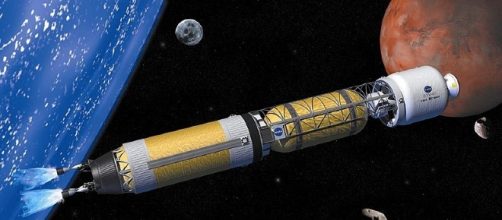The New Atlas is reporting that NASA has contracted with a company called BWXT Nuclear Energy to examine concepts for a nuclear thermal rocket engine that could take humans to Mars and beyond far quicker than chemical rockets. The plan is a revival of an old concept that was developed in the 1960s called NERVA but with some modern twists.
Why go nuclear for interplanetary travel?
A nuclear thermal rocket heats a fluid, say liquid hydrogen, in a nuclear reactor and then shoots the superheated gasses through a nozzle, creating thrust. The heat of the reactor would replace the chemical reaction of an ordinary rocket.
The result was an engine that produces more exhaust thrust and specific impulse, cutting months from a voyage to and from Mars.
The NERVA project
NASA actually developed a working nuclear thermal rocket engine called the NERVA and conducted ground tests in the 1960s. However, when a proposed mission to Mars was canceled indefinitely during the Nixon administration, the NERVA project was canceled. The idea of nuclear rockets was briefly revived during President George H. W. Bush’s Space Exploration Initiative but was just as quickly dropped when that program was canceled by President Bill Clinton.
Nuclear rockets for the Journey to Mars
While the Obama-era Journey To Mars is all but moribund, the Red Planet is still on the NASA manifest, to be visited after astronauts return to the moon.
Hence the idea of a Nuclear Rocket has been revised.
The modern twist that BWXT Nuclear will examine is to answer whether or not low enriched uranium could be used in a nuclear thermal rocket engine. The NERVA used highly enriched uranium which presented dangers due to radiation and temperature issues. Low enriched uranium would be just 20 percent Uranium 235 and would be much safer to handle and use in tests. The LEU would be mixed with tungsten to create something called ceramic-metallic (Cermet) fuel. Cermet would be far more stable under the immense heat of a nuclear reactor than standard uranium.
The $18.8 million contract, which runs through September 30, 2019, would answer the question of whether or not a cermet fueled reactor could be used to power a nuclear thermal rocket engine.
If that is the case, NASA would have the option of proceeding to build a prototype nuclear thermal rocket engine. The concept could be used to build safer nuclear reactors that would power bases on both the Moon and Mars, providing abundant energy for not only future space explorers but settlers on the high frontier.


